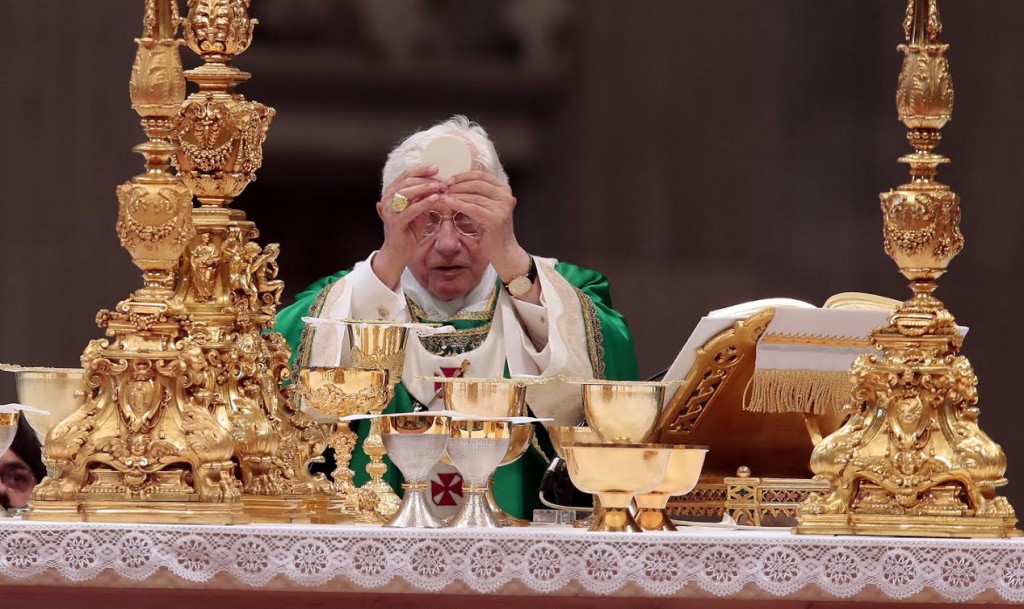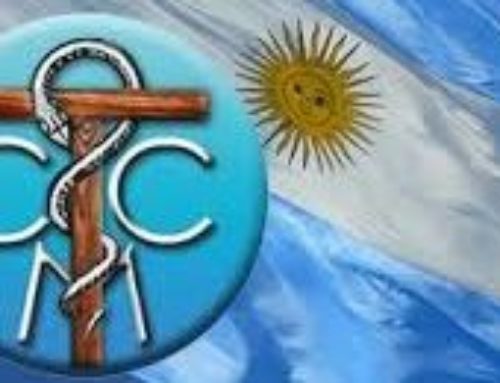Anne Lastman.
At the Last Supper Jesus instituted the Eucharist, using the elements of bread and wine, elements found in the Passover meal.

While they were eating, Jesus took bread, said the blessing, broke it, and giving it to his disciples said, “Take and eat; this is my body.” Then he took a cup, gave thanks, and gave it to them, saying, “Drink from it, all of you, for this is my blood of the covenant, which will be shed on behalf of many for the forgiveness of sins. (Matthew 26:26-28).
The Catechism of the Catholic Church explains, “This [Jesus] did in order to perpetuate the sacrifice of the cross throughout the ages until he should come again, and so to entrust to his beloved Spouse, the Church, a memorial of his death and resurrection: a sacrament of love, a sign of unity, a bond of charity, a Paschal banquet ‘in which Christ is consumed, the mind is filled with grace, and a pledge of future glory is given to us‘” (CCC 1323).
However, the question is asked, “Why bread and wine? Couldn’t Jesus have used something else?” and why eating?
It’s true, Jesus, being the second person of the Trinity, could have found a way to leave his presence in the Church which he founded on Peter, and it was possible for him to use other forms and methods to redeem including other foods. However, He chose to use unobtrusive daily fare. Unquestionable and needed daily fare which sustains life.
It has been said that the main reason why God chose bread and wine was connected to his previous revelations in the Old Testament and His preparation of his people for this moment when in the eating of the flesh and blood of the Son of God, Jesus, the reversal of that original “eating” would be accomplished.
In the Old Covenant bread and wine were offered in sacrifice among the first fruits of the earth as a sign of grateful acknowledgment to the Creator. But they also received a new significance in the context of the Exodus: the unleavened bread that Israel eats every year at Passover commemorates the haste of the departure that liberated them from Egypt; the remembrance of the manna in the desert will always recall to Israel that it lives by the bread of the Word of God; their daily bread is the fruit of the promised land, the pledge of God’s faithfulness to his promises. The “cup of blessing” at the end of the Jewish Passover meal adds to the festive joy of wine an eschatological dimension: the messianic expectation of the rebuilding of Jerusalem. When Jesus instituted the Eucharist, he gave a new and definitive meaning to the blessing of the bread and the cup. (CCC 1334)
God always knew he would use bread and wine, so he began preparing His people for this revelation gradually over time. The Old Testament scriptures are replete with symbolic precursors or types so that when Jesus came and fulfilled the reality his actions would not be to contrary to understood beliefs but an understood fulfillment of what had already taken place.
, St. Augustine in his sermon Ad infantes, de Sacramentis lays out the symbolism of the manufacturing of bread and how it expresses the “communion” we are called to celebrate.
In this loaf of bread, you are given clearly to understand how much you should love unity. I mean, was that loaf made from one grain? Weren’t there many grains of wheat? But before they came into the loaf, they were all separate; they were joined together by means of water after a certain amount of pounding and crushing. Unless wheat is ground, after all, and moistened with water, it can’t possibly get into this shape which is called bread. In the same way you too were being ground and pounded, as it were, by the humiliation of fasting and the sacrament of exorcism. Then came baptism, and you were, in a manner of speaking, moistened with water in order to be shaped into bread. But it’s not yet bread without fire to bake it. So, what does fire represent? That’s the chrism, the anointing. Oil, the fire-feeder, you see, is the sacrament of the Holy Spirit … You see, he breathes into us the charity which should set us on fire for God, and have us think lightly of the world, and burn up our straw, and purge and refine our hearts like gold. So, the Holy Spirit comes, fire after water, and you are baked into the bread which is the body of Christ. And that’s how unity is signified.
This is also confirmed in St. Paul’s letter to the Corinthians, “Because the loaf of bread is one, we, though many, are one body, for we all partake of the one loaf” (1 Corinthians 10:17).
Bread has also been a staple food in cultures around the world, something universal that everyone can understand. Wine is also a staple in most cultures as indeed in the day and culture of the Lord and so this again does not cause confusion in the use of it by the Lord.
St Augustine continued….But just as one loaf is made from single grains collected together and somehow mixed in with each other into dough, so in the same way the body of Christ is made one by the harmony of charity. And what grains are for the body of Christ, grapes are for his blood; because wine too comes out from the press, and what was separated one by one in many grapes flows together into a unity, and becomes wine. Thus, both in the bread and in the cup, there is the mystery, the sacrament, of unity. (Sermon 229A).
This is only a small sample of both reflection and the symbolic found in bread and wine that the Catholic Church has been able to ponder and make its own on from the beginning.
However, all the above explains the symbolism, reflections, the understanding of the reason for the use of bread and wine and the call to eat of this to have life “in him.” However, it does not explain why the call to eat of the flesh of the son of man “unless you eat of the flesh of the son of man and drink of his blood you have no life in you” (Jn 6: 53) these are very definitive words of Jesus. No suggestion of symbolic flesh and blood but actually eating and drinking, and to answer and understand these words we again need to go back to Genesis 3:6 “when the woman saw that the tree was good for food and pleasing to the eye, and also desirable for gaining wisdom, she took some and “ate” it. She also gave some to her husband, and he “ate” it.” It was because of the “eating” of what was forbidden that life and death and eternal life were lost. Through the command not to eat which was disobeyed. In the eating was the loss of life in God.
And as Jesus came to reverse that sin the new command was to “eat” of what was previously forbidden, that is flesh, His flesh, with blood in it (Gen 9:3-4). The sin of Adam and Eve was because they ate the forbidden fruit, the reversal was to eat of forbidden fare (flesh with blood in it) but a divine fare a divine remedy using the same action of eating.
However, in his sensitivity and care for the creature the Divine Master found a way of eating flesh and blood without contradicting the injunction of Gen 9: 3-4 and causing scandal, by the miraculous transubstantiation (by the changing of the substance but not the appearance) which occurs during the sacred moments of the consecration when common everyday elements, bread and wine are changed into the body and blood of our Lord, which still remain in appearance bread and wine but their substance truly changed into the flesh and blood of the divine Lord, ready for the eating and giving life. Unlike the eating of the fruit and giving death. This fulfills the words of Jesus “unless you eat of my flesh and drink of my blood you can have no part in me” (Jn 6:53) Fulfilling all requirements without offending the Word of God. Fulfilling all requirements for reversal of original action and sin of disobedience.









